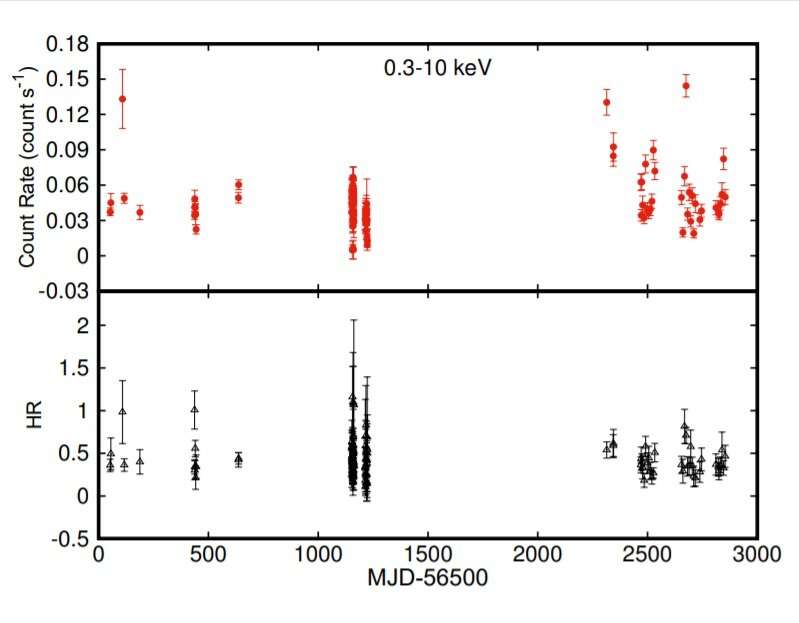November 26, 2021 report
Inspecting an ultraluminous X-ray source in the galaxy NGC 55

Using data from NASA's Swift and NuSTAR spacecraft, as well as from ESA's XMM-Newton satellite, Indian astronomers have investigated spectral and temporal properties of an ultraluminous X-ray source (ULX) in the spiral galaxy NGC 55. The study, published November 12 on arXiv.org, sheds more light on the nature of this source.
ULXs are point sources in the sky that are so bright in X-rays that each emits more radiation than 1 million suns emit at all wavelengths. They are less luminous than active galactic nuclei, but more consistently luminous than any known stellar process. Although numerous studies of ULXs have been conducted, the basic nature of these sources remains unsolved.
At a distance of about 5.8 million light years away, NGC 55, also known as the Whale Galaxy, is a magellanic-type, barred spiral galaxy with a mass of around 20 billion solar masses and size of approximately 50,000 light years. NGC 55 is a member of the Sculptor group, where the galaxies are few in number and well separated in space. Due to this NGC 55 is not rich in star-forming regions as it is not interacting with any nearby companion.
NGC 55 hosts a bright, non-nuclear ultraluminous X-ray source, designated NGC 55 ULX1, with a peak X-ray luminosity of about 2 duodecillion erg/s. Previous observations have revealed the presence of outflows and significant X-ray flux dips from this source. A team of astronomers led by Jithesh Vadakkumthani of the Inter-University Centre for Astronomy and Astrophysics (IUCAA) in Pune, India, studied this behavior by investigating spectral and temporal characteristics of NGC 55 ULX1.
"In this work, we have studied the spectral and temporal properties of NGC 55 ULX1 using Swift, XMM-Newton and NuSTAR observations conducted during 2013–2021," the researchers wrote in the paper.
NGC 55 ULX1 was identified to be in the soft ultraluminous (SUL) state of ULXs in these observations. The source exhibited variability during the monitoring campaign, where the flux varied by a factor of about 5–6. The results indicate a strong correlation between the blackbody and inner disc temperatures, which is consistent with previous studies suggesting that both components are co-evolving with each other.
According to the astronomers, NGC 55 ULX1 is a good candidate for a transitional object between classical ULXs and ultraluminous supersoft sources (ULSs), which have a dominant thermal X-ray emission below 1 keV with little or no emission at higher energies. The data suggest that the spectrum of NGC 55 ULX1 is very soft similar to ULSs, but a bright hard tail above 1 keV can be seen in the obtained spectra.
The team concluded that NGC 55 ULX1 stayed in the SUL state in the new and previous observations and did not make a transition to the ULS state, even though the flux varied by a factor of about 6. They added that the source exhibits marginal evidence of X-ray flux dips in the new Swift and XMM-Newton data at different intensity levels.
The researchers propose further monitoring of NGC 55 ULX1 using XMM-Newton and NuSTAR in different spectral states. Such observations could deliver more insights into the behavior of this source.
More information: Spectral and Temporal Properties of Ultra-luminous X-ray Source NGC 55 ULX1, arXiv:2111.06637 [astro-ph.HE] arxiv.org/abs/2111.06637
© 2021 Science X Network




















